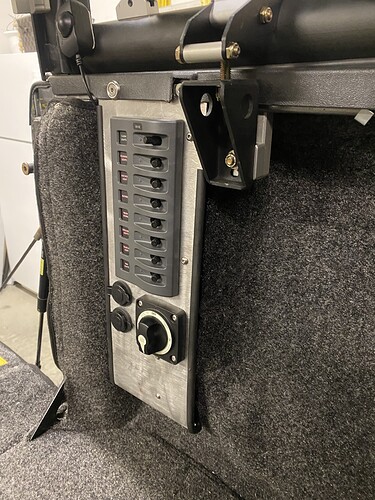As a user of said charger, I’d recommend go with bigger if your alternator can handle it. I use my second battery every single day but just driving a total of about an hour a day won’t charge the battery to full. when it’s warmer and the fridge is running I need to plug in a charger when I get home. I’m not running any solar yet and IIRC the manual said not to mix the 2 systems?
I have a 30a DC-DC and get up to 30a from my solar setup. So I see 60 amp combined charging the battery sometimes. I went with all Victron system, highly recommended.
There is no issue to run them simultaneously.
I have a set of 4 circuit breakers next to one another in my house electrical box. They control each sub-system as follows: SPod, consumers (everything besides Spod: fridge, lights, usb, etc), turn on solar charger, connect solar lines to solar charger. I also have a circuit breaker right next to my truck’s battery to that allows me to open the hood and enable power transfer from truck battery/alternator to DC to DC charger. As for fuses, I have quite a bit. To prevent any catastrophe you want a fuse or CB as close to the source as possible just in case a wire is cut, melts, or becomes lose and makes a short.
For fusing i have a 200 amp fuse at my battery positive terminal, a fuse on each parallel circuit of my solar panels, fuse tied to my 3 kW inverter, fuse for Spod, and a blue sea fuse box for each of the power consumer lines. I’ve had zero issues with the only fuse ever serving its protection purpose being one of the fuses to my LED light strips blowing because of too much power draw. I simply bumped it from 2 amp to 5 amp.
You should be able to run both solar and DC to DC at once. I’ve tested multiple inputs at once (solar, shoreline 120 V through inverter, and DC to DC at once. But in a real world application I’ve never had to run more than one at once. On a sunny day the DC to DC is typically the slowest charging system I have.
@Chuck.D How many panels do you have?
i had two 175w renogy flexible panels, neither would pull enough watts to register a charge on my battery so i returned em for a refund. renogy support is decent but they’ll make you measure the voltage and pay for return shipping unless your or their team can prove damange. in my case, they failed to evaluate in a timely manner after returning to their warehouse, so refunded me.
i realized i don’t need solar when i have a 500w charger. everytime i drive, even if its for 15 minutes, i put enough energy in my batteries that i can constantly stay in the 50-80% charge range to maximize battery life.
Just one. It’s big. Solaria 400w
I stiffened up the frame with some aluminum cross braces and made some panel supports so hopefully it holds up. It’s kinda overkill but it has the additional benefit of keeping the upstairs shaded and cool. I set it between two beef bars so they are still usable if needed.
Being a commercial panel it was a really good deal compared to buying multiple small panels.
That’s sick!!! I had to go the flush mount route because I intend on mounting my canoe to the rack in the summer. I just picked up 25’ for #4 for my Renogy 40A Dc to DC charger. So that’s the next project. It’s tough because I want to just have it working, but I also want the install to look good.
I have a solid feeling that I’ll be ripping everything out and redoing the whole set up with 1020 extrusion for the platform.
@Chuck.D What Charge controller did you use for that panel?
@Theoak Victron SmartSolar 100/30
Victron LiFePO4 battery too? My ideal setup uses the following:
Xantrex inverter (2000W)
Renogy DCC30S DC-DC charger/solar controller
Victron BMS
Victron BP65
Victron LiFePO4 house battery, 200Ah
Victron battery monitor with shunt
Blue Sea house battery isolator switch
Blue Sea SafetyHub 150
Blue Sea 9001e switch (for isolating solar and/or starter battery)
DC circuits for fridge, LED house lights, exterior camp lights (not driving), and 12V/USB outlets. AC circuits for fridge (2nd power supply) and duplex outlet. ARB twin air compressor connects directly to the starter battery. Power needed for running an induction cooktop (1500W) and working remote.
Haha pretty much! For this build I went 100% DC but I have a spare circuit for an inverter on the Safety Hub but I haven’t needed it so far.
-270ah LiFePO4 (homemade)
-Soliara 400w panel
-SmartSolar 100/30
-Orion 30a DC-DC
-BlueSmart 12/25 in engine bay
-Safetyhub 150
-Blue Sea fused switch panel
-Pacbrake air compressor and Bluetooth airbag controller to level the camper
See below thread for some old build pics.
That is sweet…especially your use of the SafetyHub 150. We had a similar idea for our Metris build that puts the key components in an easily accessed/removed drawer. I know a van builder who uses that same switch gang…keeps the toggles from inadvertently being switched. I like the Renogy DCC30S because it allows trickle charging back to the starter battery once the house is fully charged. Max. solar input is 400W.
Our control panel:
And the Metris build schematic:





